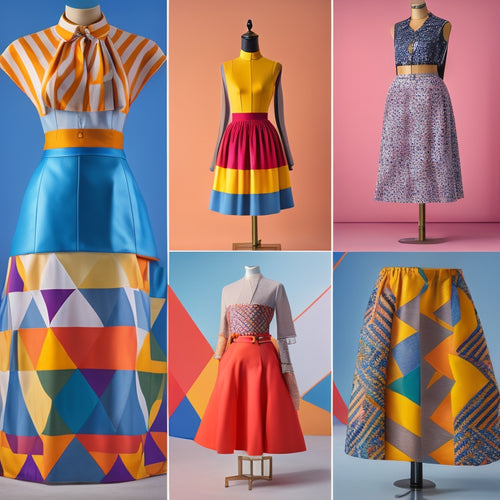
A New Way to Choreograph: Mind Mapping
Share
By integrating mind mapping into the choreographic process, dancers and choreographers can reveal abstract ideas into tangible, movement-based representations, opening up new avenues for creative expression and artistic innovation. This visual approach distills complex ideas into actionable steps, refines movement exploration, and fosters creative expression. Mind mapping also empowers educators to guide students in visualizing and planning movements, and enables choreographers to experiment with new ideas and push artistic boundaries. As you explore the intersection of mind mapping and choreography, discover how this innovative approach can enhance your creative process and bring your artistic vision to life.
Key Takeaways
• Mind mapping in choreography clarifies complex ideas, breaks down abstract concepts, and refines movement exploration for nuanced performances.
• Visual mapping empowers educators to guide students in distilling complex ideas, fostering creative expression and connecting abstract ideas to concrete movements.
• Mind mapping reveals hidden connections between elements, visualizing the narrative and conveying the intended message for impactful performances.
• This approach enables choreographers to experiment with new ideas, push artistic boundaries, and explore movement and thematic elements for resonant performances.
• By applying mind mapping to choreography, artists can uncover new insights, deepen their understanding of underlying themes, and craft compelling narratives that resonate with audiences.
Choreographing With Visual Clarity
By visually mapping the choreographic process, dancers and educators can clarify their creative vision, distilling complex ideas into tangible, movement-based representations that resonate with audiences.
This approach fosters a deeper understanding of the dance, allowing creators to tap into their visual inspiration and explore movement possibilities.
Through mind mapping, choreographers can break down abstract concepts into concrete, actionable steps, guiding their artistic decisions.
As they navigate the visual landscape of their dance, they can refine their movement exploration, teasing out nuances and subtleties that elevate the overall piece.
Mind Mapping in Dance Education
As the choreographic process unfolds, mind mapping emerges as a powerful tool in dance education. It empowers educators to guide students in distilling complex ideas into meaningful movement phrases that resonate with audiences.
Through mind mapping, students engage in dance visualization and plan movements that bring thematic explorations to life. This visual approach fosters creative expression as students connect abstract ideas to concrete movements, crafting a narrative that unfolds on stage.
Enhancing Creative Choreography Processes
Through mind mapping, choreographers can tap into the dynamic interplay between creative vision and technical execution, crafting innovative dance pieces that resonate with audiences on a deeper level. This visual approach enables choreographers to explore movement and thematic exploration, leading to more nuanced and impactful performances.
-
Uncovering hidden connections: Mind mapping reveals relationships between seemingly disparate elements, fostering a deeper understanding of the dance's underlying themes and motifs.
-
Visualizing the narrative: By mapping out the choreography, dancers can see the story unfold, making it easier to convey the intended message to the audience.
-
Embracing creative freedom: Mind mapping empowers choreographers to experiment with new ideas, take risks, and push the boundaries of their artistic expression.
Frequently Asked Questions
Can Mind Maps Be Used for Revising and Refining Choreography?
As the choreographer's compass, mind maps navigate the creative voyage, guiding revisions and refinements with precision. Unshackling creative freedom, they facilitate Choreo Evolution, illuminating the path to a masterpiece, as the dance evolves, refined and reborn.
How Do Mind Maps Accommodate Different Learning Styles?
Mind maps accommodate diverse learning styles by engaging Visual Learners through vibrant colors and images, while Kinesthetic Explorers benefit from the tactile experience of creating and rearranging ideas, fostering a dynamic and inclusive creative process.
Are Mind Maps Suitable for All Ages and Skill Levels of Dancers?
As dancers of all ages and skill levels begin a creative journey, mind maps prove universally accessible, bridging cultural sensitivities and addressing accessibility concerns, fostering inclusivity and empowerment in the choreographic process.
Can Mind Maps Be Used for Analyzing and Interpreting Existing Choreography?
When analyzing existing choreography, mind maps facilitate deconstruction strategies, visually unpacking choreographic themes, and relationships between movement, music, and narrative, allowing for nuanced interpretation and deeper understanding of the dance work's underlying structure and artistic vision.
How Do Mind Maps Facilitate Collaboration Between Dancers and Choreographers?
Mind maps facilitate collaboration between dancers and choreographers by fostering a Creative Trust, where shared ideas and visions converge, allowing for a unified, visually structured approach to choreography, ensuring a Shared Vision that resonates throughout the creative process.
Related Posts
-

Top Geometric Print Skirts to Update Your Wardrobe
To update your wardrobe with stunning geometric print skirts, look for bold colors and unique patterns that turn head...
-

Exciting Lee Kiyoung Sticker: A Must-Have
Get ready to level up your self-expression game with Lee Kiyoung stickers! These customizable cuties offer unparallel...
-

Dazzling Ballet Ticket Unveiled
The anticipation is over, as the dazzling ballet ticket design has finally been revealed, exuding elegance and sophis...


